For the team at Aurora Expeditions, puffins are not just birds; they are living works of art. Their colourful beaks, expressive eyes and endearing antics have captured the hearts of nature lovers and travellers across the globe.
Join us on a journey into the captivating world of puffins in our comprehensive Wildlife Fact File. Discover a treasure trove of information, from where they live to the different types of puffins to how they survive in the Arctic wilderness.
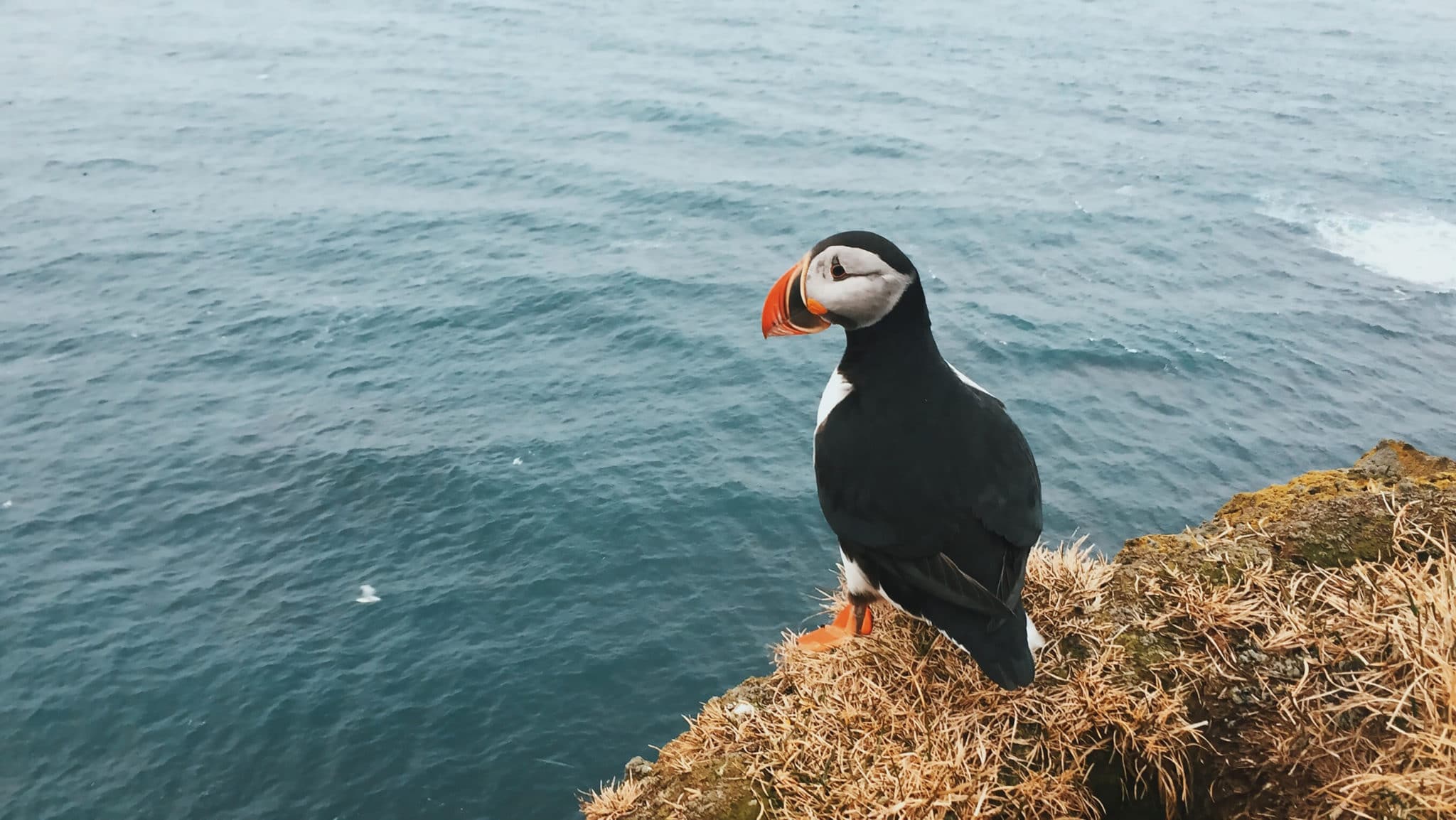
Where do puffins call home?
Puffins can be found across the Arctic, around sea cliffs and tundra-carpeted coastlines of Iceland, Greenland, Svalbard, Russia and Alaska. While puffins thrive in the high Arctic wilderness, they also nest along the coasts of Norway and Scotland, and further south across the British Isles, the Brittany coast in France, and Maine in the United States.
Puffins are very sociable, often nesting in enormous colonies. The largest documented colony in the world is an Atlantic puffin colony in the Westmann Isles of Iceland. In 2009, scientists estimated there were 4 million individual birds in a single colony, with 1 million nests between them!
While puffins tend to breed and nest in the Arctic, during winter they migrate to southern waters as far south as Baja California and Morocco.
How many types of puffin are there?
There are four different types of puffin. Puffins are members of the auk family, which includes guillemots, typical auks, auklets, murrelets, puffins and the razorbill. Let’s find out a little bit about the different puffin species.
What are the different kinds of puffins?
Atlantic puffin
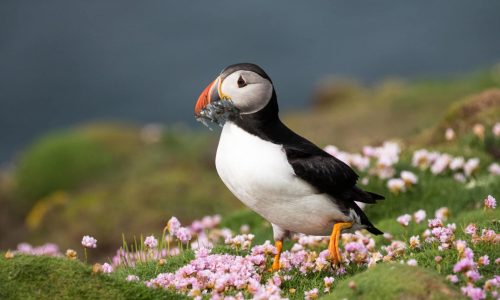
Fast facts
Scientific name: Fratercula arctica
Height: 30 cm (12 in)
Weight: 490g (1 lb)
Wingspan: 50 cm (20 in)
IUCN Red List status: Vulnerable (population decreasing)
The Atlantic puffin is the smallest of the four species, and the only one which can be seen in Europe. With an estimated population of 12 to 14 million, Atlantic puffins are by far the most numerous puffins on the planet, and can be found from the European Arctic across the Atlantic Ocean to north-eastern America.
These spectacular seabirds can be identified by their distinctive beak, which has a bright orange-red tip, a blue or grey triangle closer to their face and white stripes during breeding season. Their flamboyant beak has earned them the nickname ‘sea parrot’. They’ve also been called the ‘clowns of the sea’, a nod to their endearing awkwardness on land.
Each spring and summer, more than half of the global population of Atlantic puffins descends on Icelandic coastlines to nest and breed. They start arriving as early as April, but the best time to see them is between May and early August. With eight to ten million puffins converging on the island each year, Iceland is one of the best places on Earth to encounter Atlantic puffins.
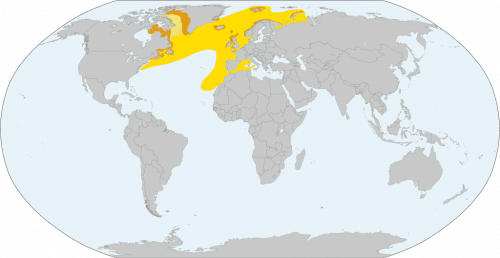
Horned puffin
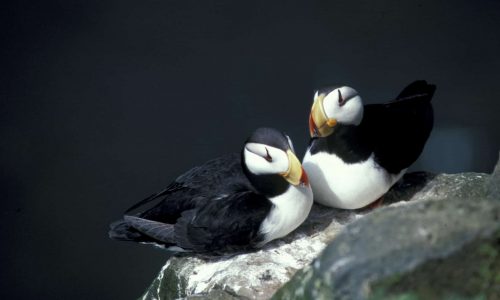
Fast facts
Scientific name: Fratercula corniculata
Height: 32 cm (13 in)
Weight: 580-650 grams (~1.3 lb)
Wingspan: approx. 60 cm (24 in)
IUCN Red List status: Least concern (population decreasing)
The Atlantic and horned puffins look very similar: the key to identification is in the beak. Look for the blue-grey triangle on the Atlantic puffin: the beak of the horned puffin is pale yellow, tapering to an orange tip. The “horns” that give the horned puffin its name are small, fleshy spikes that protrude above the eyes of breeding adults. The horned puffin also differentiates itself from other puffin species by nesting on cliffs, while the others tend to nest in earthen burrows.
There are approximately 800,000 horned puffins in the wild, with nesting grounds across the North Pacific ocean. Truly global citizens, you can find their colonies from the north coast of Japan and the Chukchi Sea to north of Russia. From here their distribution flows east along the Aleutian Islands, across southern Alaska and down Canada’s west coast, as far south as the Queen Charlotte Islands. During the winter, they migrate as far south as Baja California.
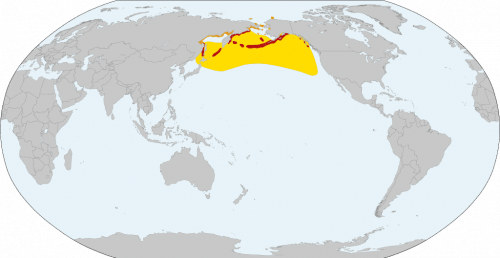
Tufted puffin
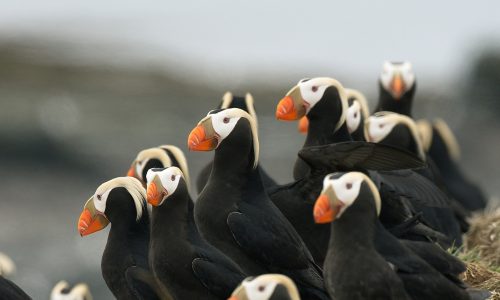
Fast facts
Scientific name: Fratercula cirrhata
Height: approx. 35 cm (14 in)
Weight: 700-840 grams (1.5-1.8 lb)
Wingspan: approx. 65 cm (25.5 in)
IUCN Red List status: Least concern (stable)
The largest member of the puffin family, the tufted puffin has a distinctive appearance, with a clear white face and long blonde plumes which lend a certain elegance to breeding birds during marine season. Tufted puffin burrows, which they dig into sea cliffs and rocky coastlines, can be more than 1.5 meters (5 feet) deep!
Like horned puffins, tufted puffins breed across the North Pacific Ocean, from northern Japan to far-eastern Russia, northwestern Alaska and down the coasts of Canada and the United States to central California. They winter at sea throughout the North Pacific Ocean.
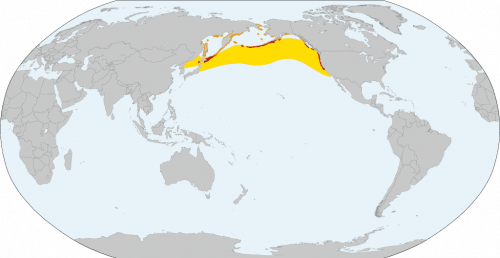
Rhinoceros auklet
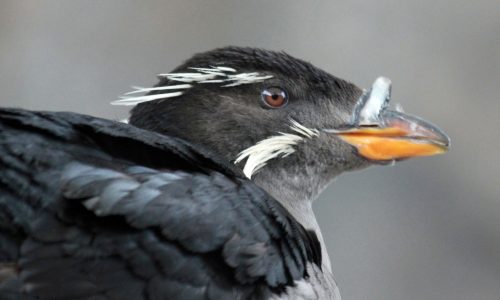
Fast facts
Scientific name: Cerorhinca monocerata
Height: 30 cm (12 in)
Weight: 350-620 grams (0.7 – 1.4 lb)
Wingspan: 57cm (22 in)
IUCN Red List status: Least concern (decreasing)
The fourth species, the rhinoceros auklet, doesn’t look like the other three – it’s sooty grey rather than black and white, and has a rhino-like protrusion from its beak during the breeding season. Puffins and rhinoceros auklets are closely related, and both are part of the tribe Fraterculini. Although rhinoceros auklets are not officially puffins, they are considered puffins anatomically, and have been known as horn-billed puffins or unicorn puffins in the past.
During the breeding season, a rhino horn-like protrusion extends from these auklets’ beaks. Long thought to be a drab, perhaps vestigial appendage, in 2019, researchers discovered that their horn is fluorescent, making it a bright beacon for animals who can see ultraviolet light – as rhinoceros auklets can. Their horn is now thought to be used for visual communication, perhaps even under water or at night.
Rhinoceros auklets are found over a similar range to horned and tufted puffins. They are abundant across the Alaska Peninsula and down the coast of British Columbia to Washington. You can also spot them across north-eastern Asia, with breeding colonies in Korea.
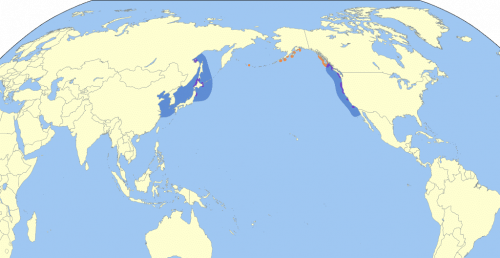
How long do puffins live?
Puffins live for about 20 years in the wild. The oldest known puffin lived to be 36 years old.
How many puffins are there today?
Between them, there are over 14 million puffins in the world. The International Union for Conservation of Nature provides these estimates for each puffin species:
- Atlantic puffin: 12-14 million
- Horned puffin: 800,000
- Tufted puffin: 2,300,000
- Rhinoceros auklet: Unknown
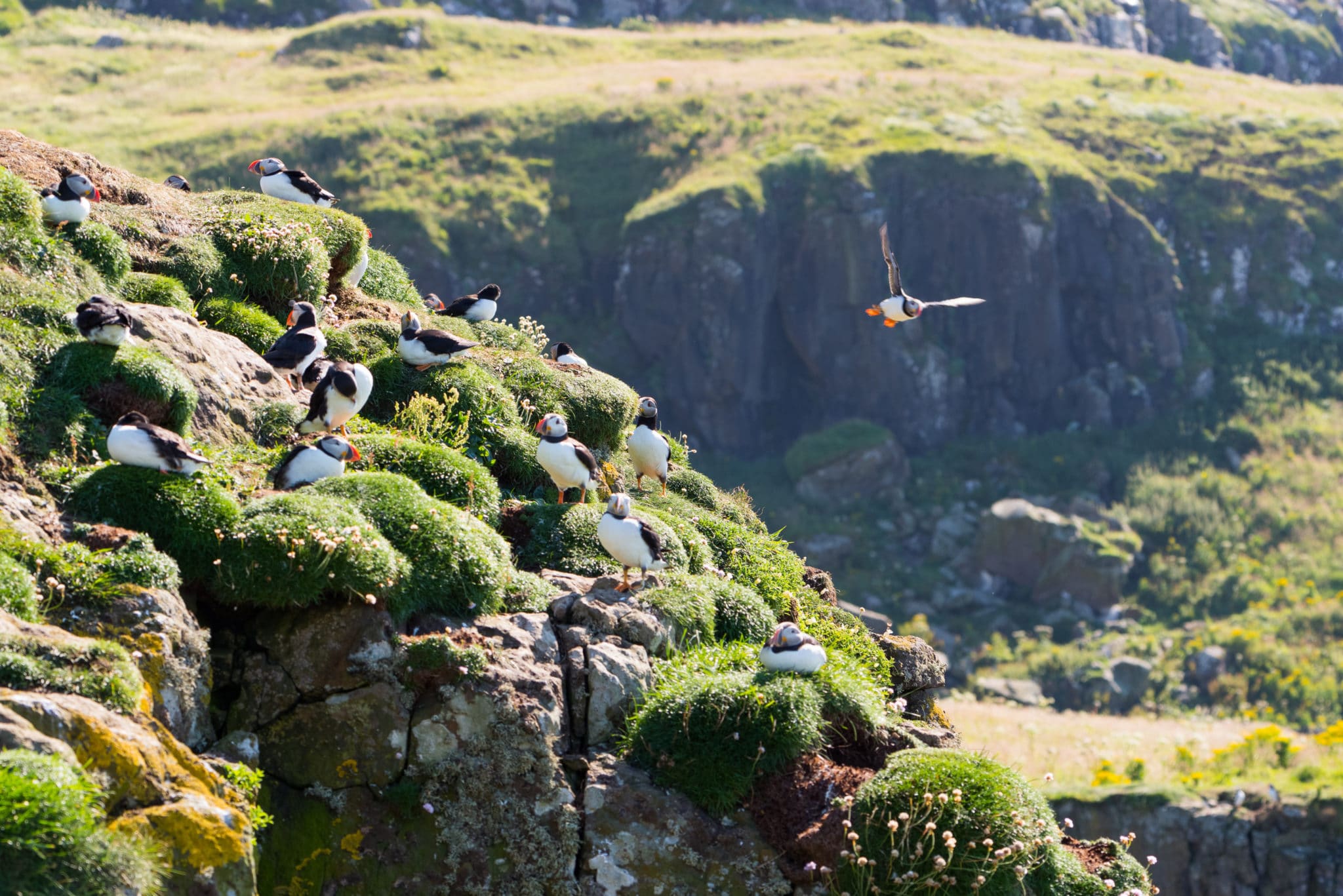
Can puffins fly in the air?
Puffins may remind us of penguins with their black and white plumage, webbed feet and seagoing ways, but in fact they are not at all related. And unlike penguins, which can’t fly, puffins are quite competent in the air. In fact, puffins are among the more capable fliers in the auk family, reaching and maintaining a cruising altitude of around 10 metres (30 feet), while others prefer to glide just a few feet above the surface. However, the puffin’s relatively small wings mean they have to work a little harder than most other seabirds to take flight and remain airborne.
Puffins have to flap furiously to catch some air, beating their short wings so fast they become a blur to onlookers. Once they’re in flight they keep flapping about 400 times per minute (that’s six times a second!) to maintain momentum, but they can reach very respectable speeds of up to 88 kilometres per hour (55 miles per hour).
Can puffins swim?
The ocean is the puffin’s domain. A little ungainly on land and passably capable in the air, puffins come into their own in the ocean. Expert divers and swimmers, their short wings provide effective propulsion through the water, and they use their webbed feet to steer a course.
Puffins dive in search of fish, with the average dive lasting roughly 30 seconds. If required, puffins can hold their breath for up to a minute, diving to depths of up to 60 metres (200 feet) in search of something suitable to eat. Rhinoceros auklets can hold their breath for up to 2.5 minutes!
What do puffins eat in the wild?
Puffins dine on a variety of zooplankton and small fish including herring, sand eels, hake and capelin. Rhinoceros auklets enjoy a diet of krill and squid. A puffin’s diet may vary a little, depending on the location of their breeding colony, and which fish are prevalent in the waters nearby. During winter, they might expand their diet to include crustaceans, but their preferred diet is fish.
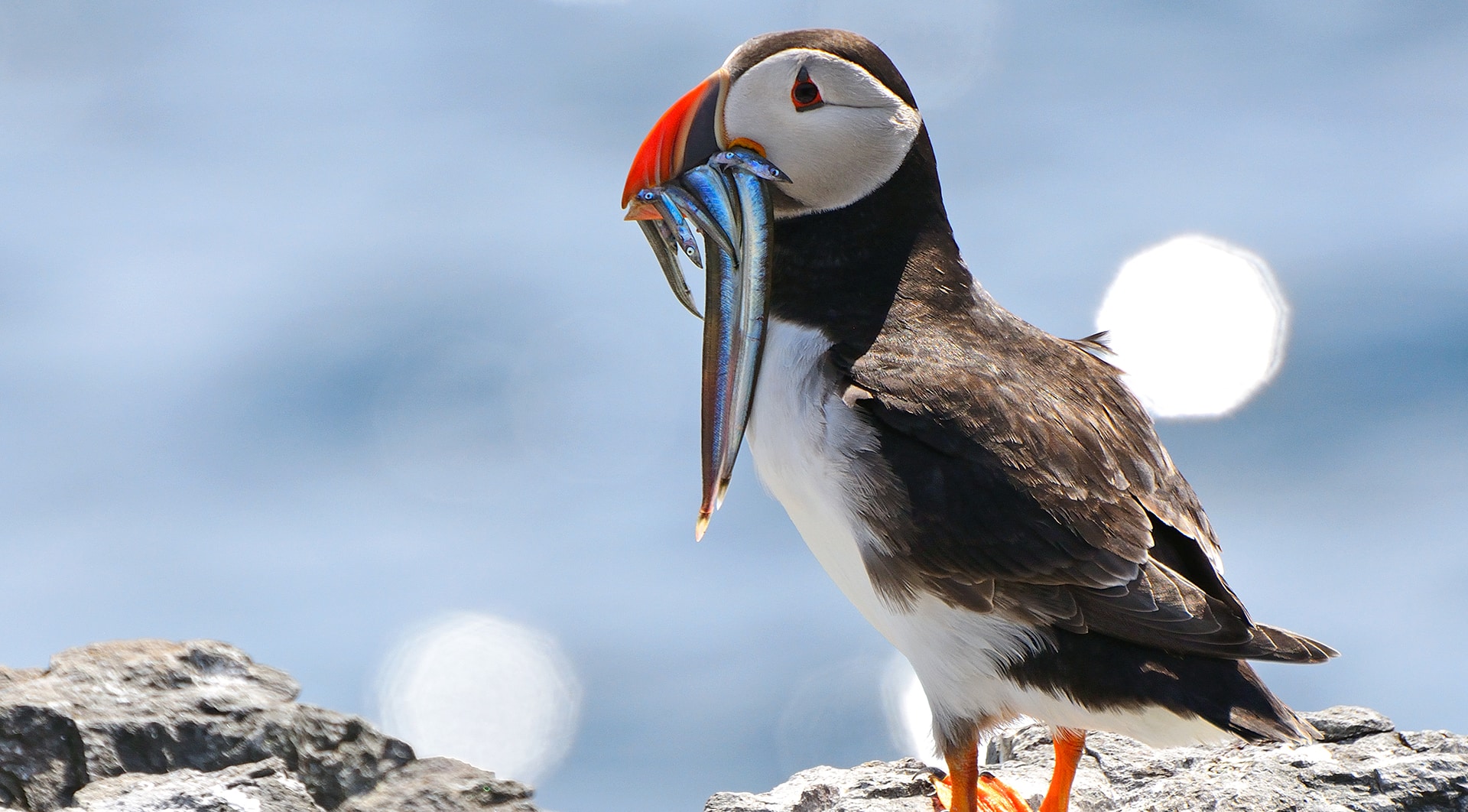
How do puffins catch fish?
Puffins are exceptional swimmers and divers, using their wings for propulsion and their feet as rudders to direct their course. They can dive up to 60 metres in search of fish, and have a unique capacity to hold several small fish in their bills at once.
How many fish can a puffin hold in its beak?
A puffin can carry as many as 10-20 fish across its beak at any one time – although there have been reports of a single puffin holding over 60! While most seabirds have to consume their food at sea and regurgitate it for their chicks, the unique anatomy of the puffin’s beak allows it to deliver whole fish to its young.
While diving, puffins use their textured tongue to lock captured fish against their upper jaw, where a series of backwards-facing spikes, called palatal denticles, holds them in place. The ability to hold multiple fish in their bills, even while diving for more, makes puffins extremely efficient hunters. This is important for puffins, as their chicks can devour up to 2,000 fish over their 35-60 day fledging period!
Where do puffins migrate?
In winter, puffins scatter widely across the Arctic, Atlantic and Pacific oceans, many of them flying hundreds of kilometres to their winter feeding grounds. Scientists are still researching exactly where different puffin populations spend the cold winter months. One thing is certain: puffins are perfectly adapted to life at sea, with superb flying and diving skills, waterproof feathers, and the ability to drink salt water.
Before winter, puffins undergo a major annual moult, and all their wing feathers are replaced. They spend several weeks unable to fly or forage, vulnerable to storms and cold, wet weather, but when they head out to sea for the winter, it is with brand new plumage.
How did puffins get their name?
The genus Fratercula, which includes the Atlantic, horned and tufted puffins, means ‘little brother of the north’ in Latin. Originally a reference to their black and white garb, which resembles a friar’s robes, some have also suggested that a puffin’s tendency to hold its feet together while taking off looks like hands clasped together in prayer.
Some say that puffins received their popular name due to the fluffy, puffy little balls of chick-shaped joy scattered across puffin colonies in summer. It doesn’t seem too far-fetched to imagine that puffins were named in honour of their chicks, little puffs of fluffy down with beaks and feet sticking out!
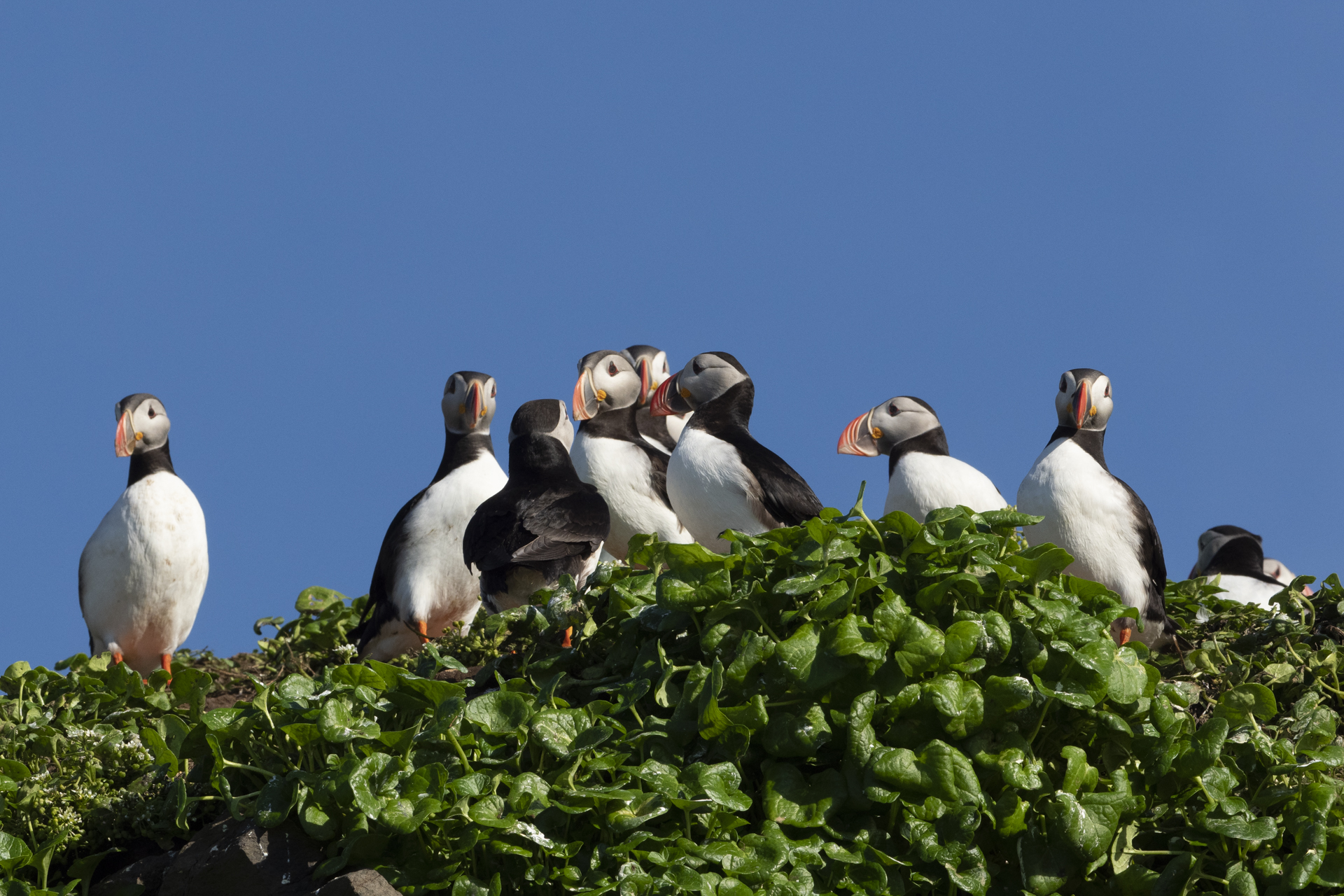
What do you call a group of puffins?
A group of puffins can be known by a range of names – a colony, a circus, a puffinry, a gathering, a burrow, or an improbability.
What is a baby puffin called?
A baby puffin is called a ‘puffling’. Yes, you read that right!
When do puffins nest?
Puffins generally return to their nesting grounds in mid-April each year. They depart for another winter at sea by the end of August. Puffins nest in deep burrows that can be over a metre (3 feet) deep, with the exception of the horned puffin, which tends to nest on sea cliffs.
Puffins typically lay 1 egg per year. The male and female share the duties of incubating the egg for around 40 days before it will hatch. Puffin chicks are fluffy, ravenous little birds, which need a lot of care and several feedings per day. Both parents share the work of rearing and feeding their chick for several months each summer, until it reaches maturity and is ready to strike out on its own.
Do puffins mate for life?
Puffins mate for life, returning to the exact same burrow year after year to reunite and raise another chick. Given that puffins begin breeding around the age of five and live to an average of 20 years, that’s quite a commitment!
After a long winter at sea, penguin partners reconnect by bumping beaks and giving one another a quick peck on the cheek in a courtship display called ‘billing’. Billing is a social, somewhat flirtatious behaviour that isn’t reserved exclusively for a mate. While friendly puffins may bill, they save their true affections and mating behaviours for their partner alone.
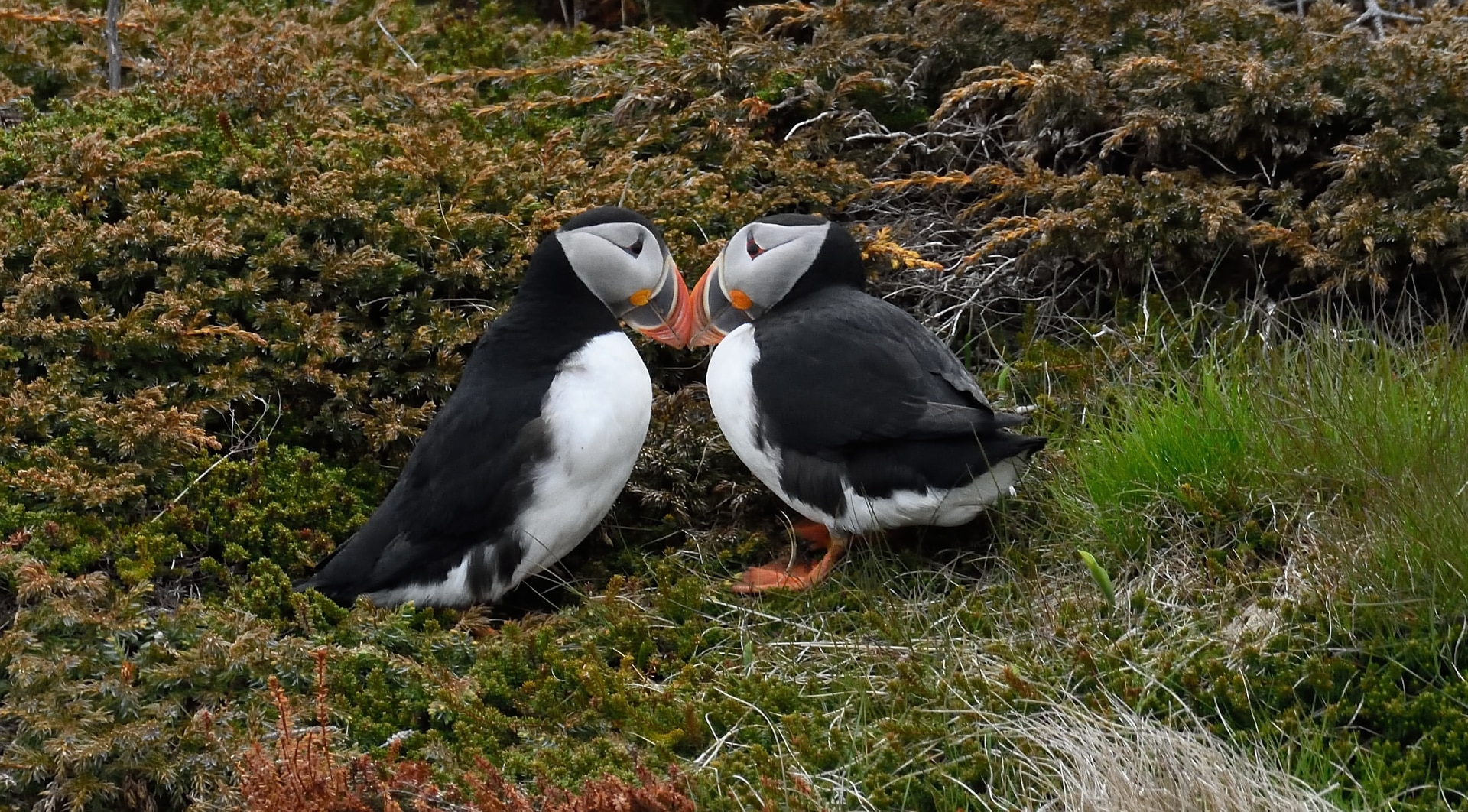
Do puffins fight one another?
A well-developed system of social niceties make life in a puffin colony generally harmonious, but puffins do engage in scuffles if provoked.
Puffins are very social birds, forming immense breeding colonies, often in quite confined coastal areas. They rely on body language and physical cues to communicate their intentions and minimise conflict with neighbours. For example, when a puffin returns to their nest after a flight, they will place one foot in front of the other and pause with their wings extended. This passive posture allows them to re-join the community without incident. A puffin looking to pass peacefully through another’s territory points its beak down to its chest and moves quickly, without stopping.
If provoked, a puffin will show its displeasure by ‘gaping’: extending its wings, opening its beak slightly, and puffing its feathers up. As they become more aggravated, puffins open their beaks wider, sometimes stomping their feet for emphasis. If the puffins are unable to resolve their differences, they will engage in a beak-to-beak fight, locking their bills, attempting to knock their opponent off their feet in a frenzy of flapping wings and stamping feet. This spectacle can attract throngs of onlookers – human and puffin alike – watching the wrestlers with bated breath.
What animal eats puffins?
The puffin’s main predator is the great black-backed gull. These large, powerful gulls snatch puffins up out of their burrows, or grab them mid-flight. Herring gulls drag puffin eggs and chicks away from nests, and steal food from adults, sometimes pursuing them from the sea to their nests, hoping to snaffle a few fish from the recent foraging run. Foxes and rats also prey on puffins.
How do puffins protect themselves?
Puffins avoid thieving herring gulls by circling over their burrow before landing. This gives them a good aerial view of the colony, allowing them to time their landings and steer clear of would-be robbers.
When pursued by predators, puffins flee for the safety of their burrow or the sea. If attacked directly, they will fight back, pecking the predator with their beak and scratching with their sharp claws.
To find out how to experience the puffin’s extraordinary antics for yourself, contact our team or your preferred travel advisor for a chat today.
Featured Expeditions
Join us on an Arctic expedition or discovery voyage in Scotland, Iceland, Greenland or Norway for the chance to catch a glimpse of a charismatic puffin and other iconic Arctic wildlife.
Wild Scotland
Discovery
Discover the wild isles of Scotland, from the windswept Hebrides, inhabited for over 8,000 years, to the verdant Orkney Islands, where ancient Neolithic and Viking sites conjure images of civilisations...
12 Days
From AUD $17,590.75/pp
Arctic Complete - Svalbard, Greenland & Iceland
Expedition
Combine Jewels of the Arctic with Svalbard Odyssey for a complete exploration of the European Arctic’s west side. From Reykjavik, embark on a voyage to Svalbard, scanning for whales, and...
24 Days
From AUD $35,865.75/pp
Svalbard Odyssey
Expedition
Enjoy the best of Svalbard, a world of near-endless daylight, where polar bear sightings quicken your pulse, guillemot cries echo from towering cliffs, and beluga whales rise from the sea....
12 Days
From AUD $17,365.50/pp
Iceland: Circumnavigating the Land of Fire & Ice
Discovery
Welcome to Aurora Expeditions’ Iceland: Circumnavigating the Land of Fire & Ice expedition.Explore the ‘Land of Ice and Fire’ where snow-capped peaks rise above glaciers and active volcanoes rumble. Explore...
11-12 Days
From AUD $14,870.75/pp
Northwest Passage
Expedition
Welcome to Aurora’s Northwest Passage expedition. The labyrinthine channels of the legendary Northwest Passage have enchanted explorers and adventurers for centuries and have been home to the local Inuit and their...
16-17 Days
From AUD $29,405.75/pp
Greenland Odyssey
Expedition
Experience the enormity of Greenland – the world’s largest island – where jagged peaks pierce azure skies, and countless glaciers snake their way towards the coast. Sail along deep fjords,...
17 Days
From AUD $24,636.00/pp

